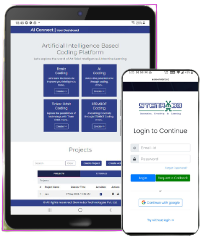Why Every Student Should Run a STEM Audit of Their Daily Life
The world today is rapidly evolving and so are the situations and problems. The chance to create something extraordinary is not limited to high tech laboratories or companies, it is in our day to day problems; problems that we face everyday and still choose to ignore it. There are numerous moments in our daily lives where these subjects of STEM – science, technology, engineering and mathematics intersect. Imagine if students began tracking their daily lives through this perspective. They would soon discover countless hidden problems waiting for simple, smart solutions. That’s the power of a STEM audit. And now, with Coding and Robotics Curriculum for Schools, it becomes much easier. The Untapped Potential of Everyday Problems According to a 2023 NITI Aayog report, India adds nearly 3.1 crore students to higher education each year. If even a fraction of them were encouraged to conduct a STEM audit, the collective potential for innovation would be massive. “Students are uniquely placed because they notice problems with a fresh perspective, unburdened by the inertia of how things have always been done,” says a senior education technology expert.In simple words, STEM audit helps us know ourselves better so that we can fill in our blanks with knowledge through practice and precision.“This curiosity, when guided with STEM skills, can be converted into real solutions.” From Observation to Innovation Running a STEM audit of daily life does not require waiting for grand challenges. It is pure observation: Why is there so much food wasted in the hostel mess? Why are classrooms still following traditional methods instead of adopting a modern curriculum for schools that integrates STEM? Why are rural homes still struggling with reliable power? When examined with a STEM mindset, these questions transform into solutions. Many students today are building apps, robots, and devices that answer everyday problems. This is exactly what coding and AI platforms providers companies like us, enable by giving students real-world skills and Robotics Curriculum for Schools. Industry leaders believe such practices not only sharpen students’ problem-solving abilities but also prepare them for the future workforce. “The companies of tomorrow are not just looking for degree holders; they are looking for thinkers who can observe a problem, ideate, prototype, and implement,” says a senior manager from a leading educational technology company. Building a Culture of Innovation India has taken many important steps to ensure students are future-ready. And the role of AI in education sector made way for initiatives like Atal Tinkering Labs under NITI Aayog’s Atal Innovation Mission and experiential learning under the National Education Policy 2020 show clear intent. Yet, a cultural shift is still needed. Innovation cannot remain limited to competitions or labs, it has to become part of daily thinking. A STEM audit makes this mindset habitual. When students treat their campus, canteen, or even neighbourhood as a living laboratory, they start seeing how classroom theories apply to real challenges. Universities that encourage such practices often produce successful entrepreneurs. Many student startups in India whether in edtech, renewable energy, or health-tech trace their origins to simple observations. STEM innovation and learning centres, along with Tinker and innovation programs for schools, are already proving how everyday curiosity can spark big ideas and encourage design thinking. These setups encourage students to test, prototype, and create real solutions. They also align with the push for innovative ideas for school development across India. The Role of Mentors and Industry Curiosity is the most important 21st-century skill. And it is strengthened through guidance. As Dr. Anuradha Prasad, an innovation consultant, explains, “Students need someone to help them move from just spotting a problem to actually building a solution.” A STEM audit works best when there’s an ecosystem where ideas are discussed, tested, and refined. This is where STEMROBO come to play, which designs robotics syllabus for school students, provide not just tools but also mentorship frameworks. By offering access to robotics kits, coding platforms, and even an artificial intelligence course for kids, such companies ensure that ideas don’t stop at the brainstorming stage but evolve into impactful solutions. Beyond Skill Development: A Social Responsibility Robotics projects for school students, help young people start looking at their surroundings with empathy and STEM knowledge, they design solutions that improve lives. For example, a cheap water purifier for rural homes, a solar-powered charging point in a village, or even a chatbot that supports mental health can all emerge from daily STEM audits. These innovations don’t just build careers they uplift communities. Globally, student-led projects are being recognised for their potential. In 2022, a group of Indian students won recognition at the World Robot Olympiad for building a robot that assisted differently-abled individuals. Their inspirational journey didn’t began from a posh lab but through observations, design thinking etc. A STEM audit is in very easy terms, a combination of SWOT analysis and design thinking, it helps identify gaps and opportunities, making learning more practical and impactful. Running a STEM audit of daily life is not about adding pressure to a student’s busy schedule; it is about shifting perspective. By applying STEM consciously, with the help of Coding and AI Platforms providers Company, like ours, students sharpen their skills and uncover opportunities to make a difference. India’s youth is often called its greatest asset. But assets deliver value only when put to use. By adopting a STEM audit mindset, students can move from being passive users of technology to active problem-solvers. In doing so, they will not only prepare for their future, they will help design it. Change is very inevitable, but progress is same, intentional. The changemakers of tomorrow will be those people, who identify problems with empathy and create solutions that are both economical and accessible. A STEM audit is the first and foremost step toward this larger vision. If every student begins this journey today, tomorrow’s India will not just be tech-driven, it will be innovation-led.
Why Every Student Should Run a STEM Audit of Their Daily Life Read More »







